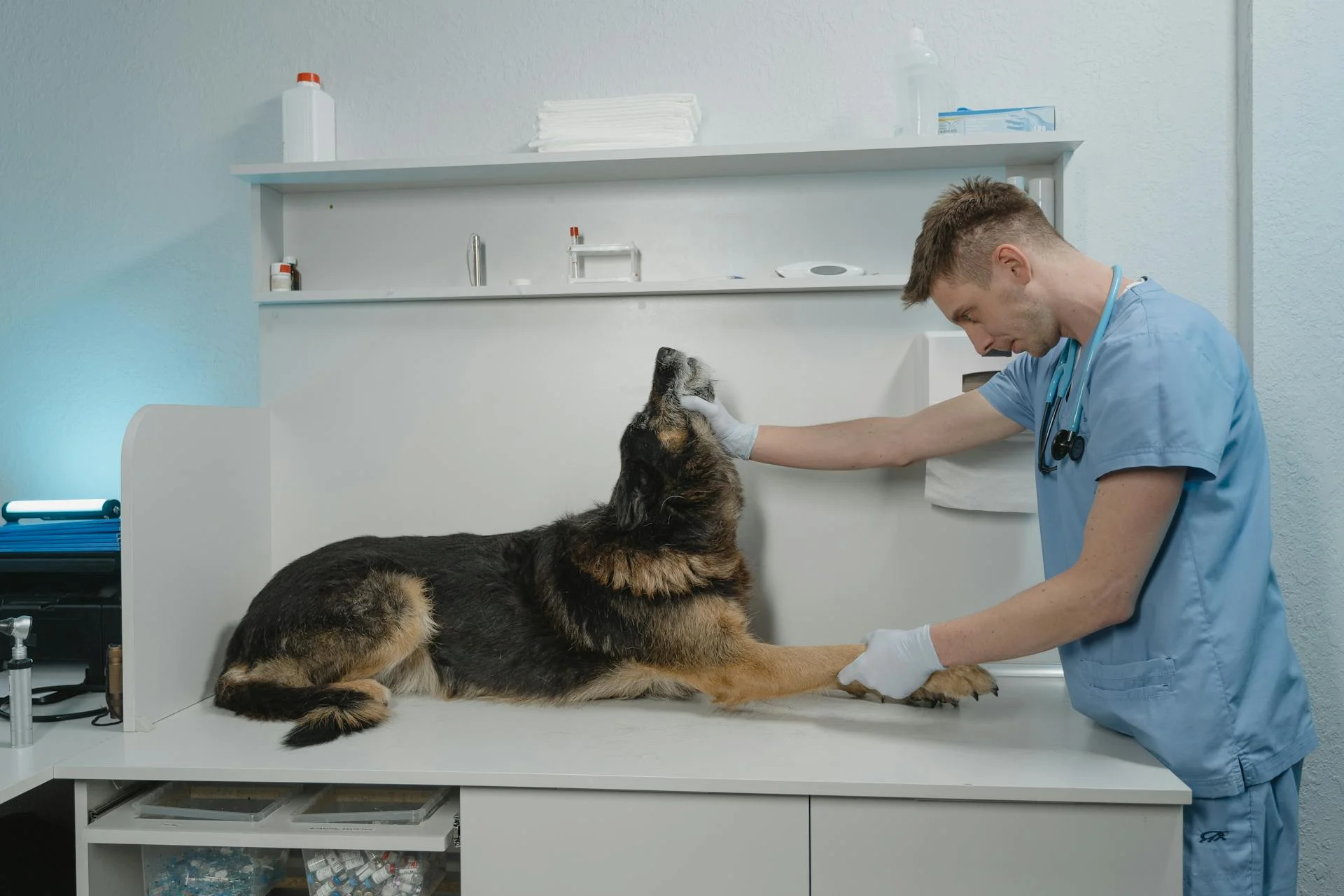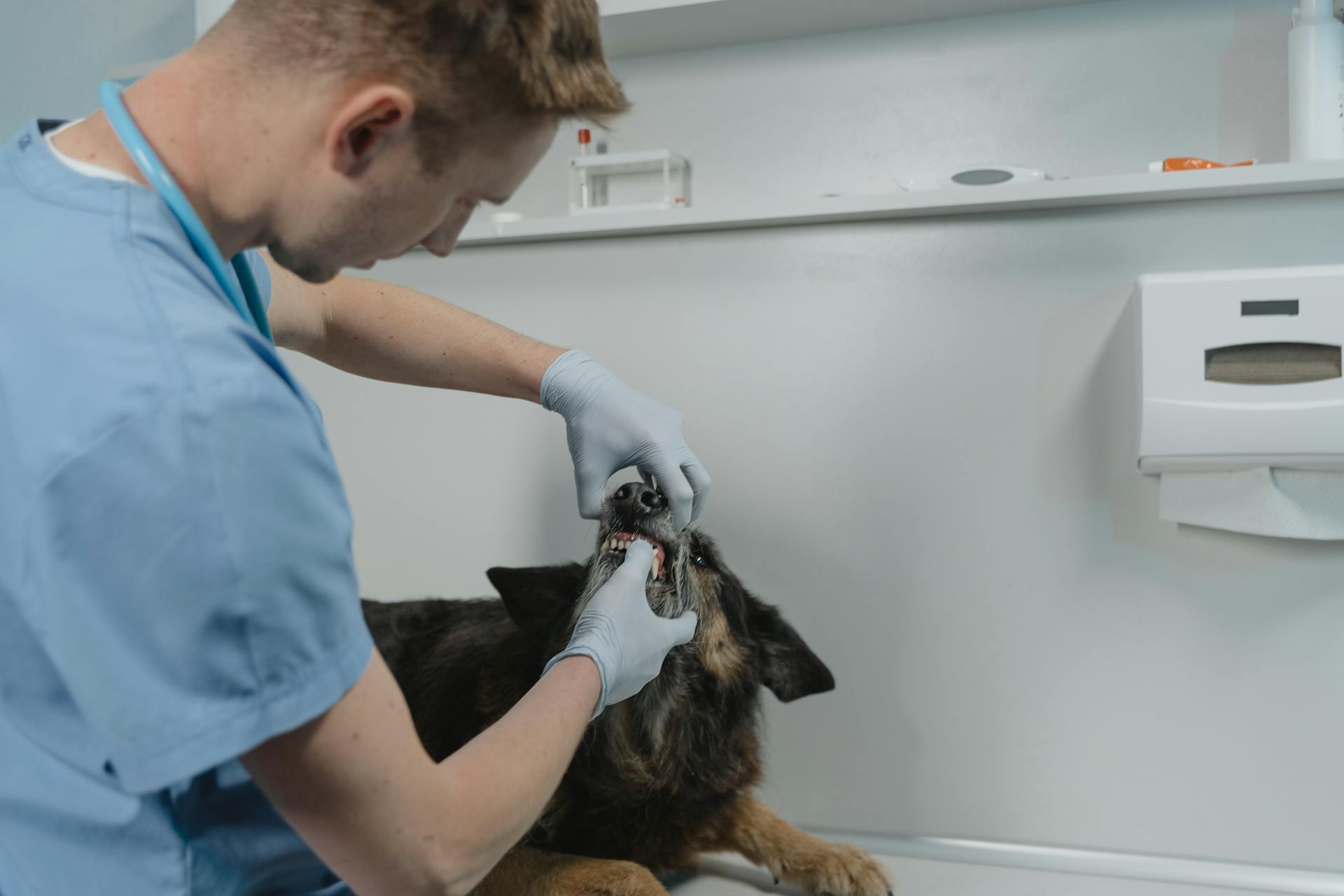
Canine prostate cancer can be a challenging diagnosis for pet owners, but understanding the symptoms, diagnosis, and treatment options can help you make informed decisions for your furry friend.
The most common symptoms of canine prostate cancer include difficulty urinating, straining to urinate, and blood in the urine or semen.
As a pet owner, it's essential to monitor your dog's urination habits and watch for any changes in their behavior.
Prostate cancer in dogs is often diagnosed between the ages of 10 and 14, with some breeds being more prone to the disease than others.
A veterinarian can diagnose prostate cancer through a combination of physical examination, imaging tests, and a biopsy.
Treatment options for canine prostate cancer vary depending on the stage and severity of the disease, but may include surgery, chemotherapy, and hormone therapy.
Broaden your view: Canine Cancer Treatment
What Is Canine Prostate Cancer?
Canine prostate cancer is a rare but highly malignant condition in dogs.
It's more common in certain breeds such as the Bouvier des Flandres, Doberman, and some German pointer breeds.
The average age of diagnosis is around 10 years.
Dogs with this condition often show symptoms like listlessness, weight loss, discomfort, and pain.
Difficulty urinating and defecating, and lameness due to bone metastasis are also common symptoms.
Unlike human prostate cancer, canine prostate cancer is highly aggressive and often spreads to organs like the lungs, bones, and lymph nodes before diagnosis.
Neutered dogs are also more likely to develop this condition.
Treatment options are limited due to the risk of the cancer spreading before diagnosis.
A clinical trial is currently underway at the veterinary school at U C Davis using a human surgical procedure to reduce cancer size and improve quality of life.
Symptoms and Diagnosis
Symptoms of canine prostate cancer can be quite varied and may not always be immediately apparent. The most common symptoms are related to the urinary tract, including straining to urinate, frequent urination with small amounts of urine, and blood in the urine.
Difficulty urinating can lead to further complications, such as infection and trouble urinating. In some cases, the cancer can spread to other organs, causing additional symptoms.
Here are some common symptoms of canine prostate cancer:
- Difficulty urinating (stranguria)
- Blood in the urine (hematuria)
- Frequent attempts to urinate
- Difficulty defecating
- Lameness in the hind legs
- Abnormal posture (especially while urinating)
- Abnormal gait with short steps
- Pain
- General weakness
- Weight loss
- Fever
Symptoms
Symptoms of prostate cancer in dogs can be quite concerning for pet owners. Difficulty urinating, or stranguria, is a common symptom, where dogs may strain to urinate or only produce small amounts of urine at a time.
Blood in the urine, known as hematuria, is another possible symptom. This can be a sign of a more advanced case of prostate cancer.
Frequent attempts to urinate can also be a symptom, as the prostate cancer can cause the urethra to become compressed. This can lead to discomfort and anxiety for the dog.
Difficulty defecating can also occur if the prostate cancer has spread to the colon. In such cases, dogs may strain to defecate or produce abnormal-appearing stools.

In some cases, prostate cancer can spread to the bones, leading to lameness in the hind legs. Dogs may also display abnormal posture, especially while urinating.
Other symptoms can include pain, general weakness, weight loss, and fever.
Here are some common symptoms of prostate cancer in dogs:
- Difficulty urinating (stranguria)
- Blood in the urine (hematuria)
- Frequent attempts to urinate
- Difficulty defecating
- Lameness in the hind legs
- Abnormal posture (especially while urinating)
- Abnormal gait with short steps
- Pain
- General weakness
- Weight loss
- Fever
Diagnosis
Diagnosis typically starts with a thorough physical examination, including a rectal palpation, to check for signs of an enlarged or abnormally shaped prostate.
The veterinarian will also perform urinalysis to look for small samples of cancerous cells, which can be an effective way of confirming suspected prostate cancer.
Bloodwork will be taken to evaluate for infection or systemic illness, which might suggest another cause for your dog's symptoms.
Ultrasound is a valuable tool in diagnosing prostate cancer, as it can help evaluate the size and shape of the prostate, as well as check for local metastasis.
In some cases, an ultrasound-guided biopsy may be necessary to obtain a larger sample of the tumor and diagnose the type of cancer and the degree of malignancy, if possible.
About 80% of dogs with prostatic adenocarcinoma have some type of metastasis present upon diagnosis, which may require further X-rays of the bones or lungs to check for metastasis to these areas.
You might enjoy: Do Male Dogs Have a Prostate
Therapeutic Effectiveness
Prostate cancer in dogs is a serious condition, and treatment options vary depending on the stage of the disease. Surgery is rarely an effective way to eliminate the cancer due to the high rate of metastasis and potential for incontinence.
Palliative care is often recommended for dogs with advanced prostate cancer, focusing on relieving pain and improving quality of life. A stent may be placed in the urethra to alleviate urinary obstruction.
Chemotherapy can be considered, but long-term efficacy has not been established. Radiation therapy may be recommended in certain cases, often combined with chemotherapy and NSAIDs for more effective treatment.
The most effective treatment for canine prostate cancer involves radiation therapy, combined with chemotherapy and NSAIDs, which can increase the survival time to about 20 months. Intensity-modulated image-guided radiation treatment (IM/IGRT) is more effective than external beam radiation for this type of tumor.
Dogs undergoing radiation therapy often experience gastrointestinal or genitourinary toxicosis, and may need to be hospitalized for monitoring side effects.
You might enjoy: Canine Leishmaniasis Treatment
Recovery and Management
Early detection is key to extending your dog's survival time. If prostate cancer is detected before it has spread, more definitive treatment can be performed.
The chances of recovery vary depending on the aggressiveness of the tumor and the time of diagnosis. If the cancer is found early, before metastasis is present, chemotherapy and radiation treatment may be effective.
Monitoring your dog closely, especially as he ages, is crucial for detecting prostate disease in its precancerous stages. This can help give your dog the highest chance of effective treatment.
Once the cancer has spread, management of clinical signs is often performed to control the disease as long as possible.
For more insights, see: Canine Lupus Disease
Complications and Future Research
Urinary incontinence has been described as a potentially serious complication of prostatectomy in dogs. It's a concerning issue, as estimates suggest it can occur in up to 100% of cases, with some studies reporting rates as high as 33% to 100%.
In some studies, urinary incontinence was not mentioned, suggesting it may not be a common complication in all cases. However, in a study of 25 dogs that underwent total prostatectomy, 8 dogs (32%) suffered from permanent urinary incontinence.
Urinary tract infections (UTIs) were also mentioned as a complication in a few studies. In one study, a UTI was present in one animal before the surgery and couldn't be linked to the procedure as a complication.
Some studies have suggested that prostatic cancer itself may play a role in the development of urinary incontinence, as it occurs more frequently in dogs with prostatic neoplasia than in normal dogs.
Here are some specific complications mentioned in the studies:
- Persistent dysuria and stranguria
- Urinary tract infection
- Severe complications in 3 dogs
- Grade 1 (Severe) complications: 3 dogs
- Grade 2 complications: all dogs
- Grade 3 (Minor) complications: all dogs
- Anastomosis leak, urinary tract infection
- Obstructed urination
Table 2. Complications
Complications can be a major concern when it comes to prostatectomy in dogs. According to Table 2, urinary incontinence was a complication in some studies, with estimates ranging from 33% to 100%.
Urinary incontinence can be a serious issue, and studies have shown that it occurs more frequently in dogs with prostatic neoplasia than in normal dogs. In the study by Bennett et al. (2018), 8 out of 25 dogs (32%) that underwent total prostatectomy suffered permanent urinary incontinence.

Urinary incontinence was not reported in dogs with prostate cancer undergoing partial or subtotal prostatectomy in some studies. However, it's worth noting that the study by Liptak et al. (2004) found that urinary incontinence did not occur in dogs with prostatic carcinoma.
Other complications mentioned in the table include urinary tract infections (UTIs), which were reported in two studies. In the study by Liptak et al. (2004), UTI was already present in one animal before the surgery and could not be linked to the procedure as a complication.
Here are some of the complications mentioned in the table:
It's clear that complications can be a significant concern when it comes to prostatectomy in dogs. More research is needed to fully understand the risks and consequences of this procedure.
Future Research
Research on the topic of complications associated with a specific medical device has highlighted the need for further investigation into the long-term effects of its use.

Studies have shown that the device's design can lead to tissue damage and scarring, which can have serious consequences for patients.
Further research is necessary to determine the optimal placement and adjustment of the device to minimize these risks.
The development of new materials and technologies could also lead to improved device design and reduced complications.
Frequently Asked Questions
How long should I let my dog live with cancer?
Life expectancy with cancer varies, but in aggressive cases, treatment may only extend life by 3-4 months. Researching your dog's specific cancer type can help determine the best course of action
How long does a dog have to live with prostate cancer?
Dogs with prostate cancer typically live for about eight months after receiving treatment. However, with proper care and management, some dogs may live longer.
How aggressive is prostate cancer in dogs?
Prostate cancer in dogs is locally aggressive, meaning it can spread to nearby areas, and has a high chance of metastasizing to other parts of the body, such as lymph nodes, lungs, and bones. Understanding the behavior and treatment options for this type of cancer is crucial for effective management and care.
What age do dogs get prostate cancer?
Dogs typically develop prostate cancer between 8.5 to 11.2 years of age. A definitive diagnosis requires a cytological or histological exam.
Are dogs with prostate cancer in pain?
Yes, dogs with prostate cancer may experience significant pain, especially in the back or abdomen, and it can worsen if the cancer has spread to the bones. Pain is a common symptom of prostate cancer in dogs, requiring prompt veterinary attention.
Sources
- https://www.petmd.com/dog/conditions/cancer/c_dg_adenocarcinoma_prostate
- https://kaliswish.org/canine-prostate-cancer/
- https://www.pethealthnetwork.com/dog-health/dog-diseases-conditions-a-z/prostate-cancer-and-prostate-disease-dogs
- https://www.ncbi.nlm.nih.gov/pmc/articles/PMC7703606/
- https://wagwalking.com/condition/prostate-cancer-adenocarcinoma
Featured Images: pexels.com


